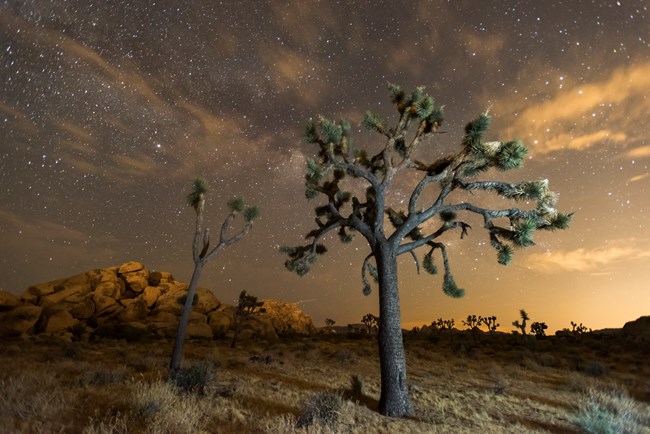
NPS Photo
Joshua Tree National Park was first established as a national monument in 1936 and then as a national park in 1994. Joshua Tree is the southern-most park in the Mojave Desert Network, lying at the transition between Mojave and Sonoran deserts.
Providing major habitat for its namesake, the park supports extensive stands of Joshua trees, prickly pear cacti, and other unique and diverse plants and animals. Fault lines running through igneous and metamorphic rocks force water to the surface at numerous locations across the park. Five of North America's 158 desert fan palm oases are found at these locations. Many threatened or vulnerable species call the land of Joshua Tree National Park home, including the desert tortoise, desert bighorn sheep, Mojave fringe-toed lizard, and sensitive bat species.
The Mojave Desert Network provides natural resource inventory and monitoring information to help parks make effective, science-based management decisions. Inventories have been completed for mammals, fish, birds, vascular plants, and reptiles & amphibians (see species lists further down the page). Maps and Reports detailing Joshua Tree's vegetation, soils, and geology resources are also complete.
Monitoring at Joshua Tree National Park
Ongoing Monitoring Efforts
Bats monitoring bat populations using acoustic and capture surveys
Desert Springs monitoring water quality and availability at 48 smaller seeps and springs
Integrated Uplands vegetation and soils monitoring of the Joshua Tree woodland community
Invasive & Exotic Plants monitoring plan for detecting invasive plants throughout the Park
Selected Large Springs monitoring water quality and availability at Fortynine Palms Oasis and Smith Water Canyon Spring
Spring Vegetation monitoring desert spring plant communities at select springs
Weather and Climate monitoring temperature, precipitation, wind and other variables at park service and partner weather stations
Comparison of water presence at Sparrow Spring, Joshua Tree, in 2006 and 2017


Left image
Sparrow Spring, Joshua Tree, January 2006. This photo was taken during the initial desert springs inventory on January 15th, 2006. Surface water was present at the spring during the visit.
Credit: NPS Photo
Right image
Sparrow Spring, Joshua Tree, February 2017. This photo was taken during the recent Joshua Tree desert springs monitoring field season on February 8th, 2017. No surface water was present during the visit.
Credit: NPS Photo
Reports & Publications
Inventories & Assessments present baseline data collected during the first phase of the development of the Mojave Desert Inventory & Monitoring Network in order to have comparison with the long-term monitoring data currently being collected. Monitoring protocols describe why and how we collect, manage, analyze, and report monitoring data about the network's Vital Signs. The protocols consist of a narrative and associated set of standard operating procedures (SOPs). Monitoring Reports summarize data and findings from our Vital Signs monitoring activities.
Source: NPS DataStore Collection 4376 (results presented are a subset). To search for additional information, visit the NPS DataStore.
Source: NPS DataStore Collection 4378 (results presented are a subset). To search for additional information, visit the NPS DataStore.
Source: NPS DataStore Collection 4380 (results presented are a subset). To search for additional information, visit the NPS DataStore.
Source: NPS DataStore Collection 4379 (results presented are a subset). To search for additional information, visit the NPS DataStore.
Select a Park:
Select a Species Category (optional):
Visit NPSpecies for more comprehensive information and advanced search capability. Have a suggestion or comment on this list? Let us know.
Last updated: May 31, 2023
